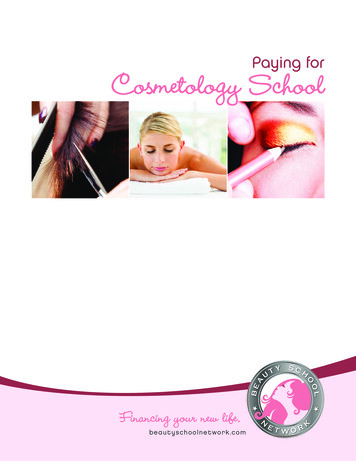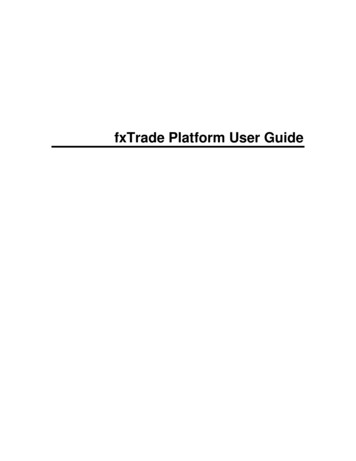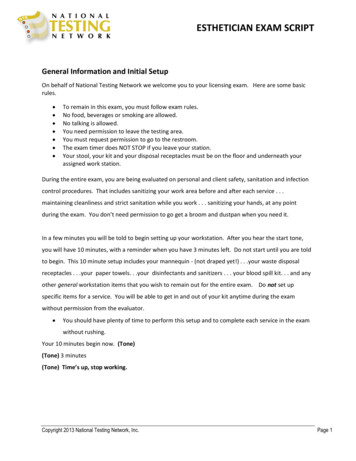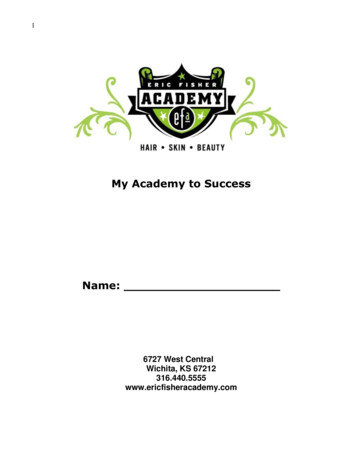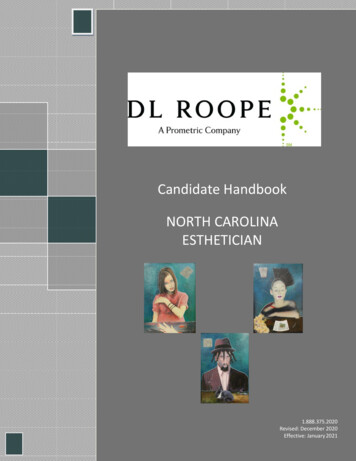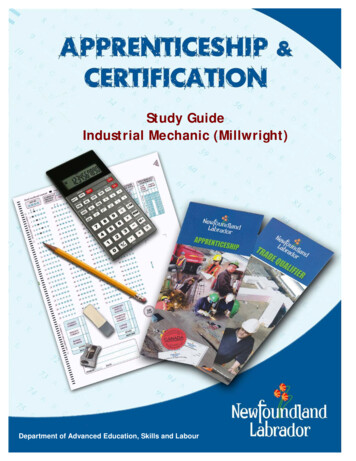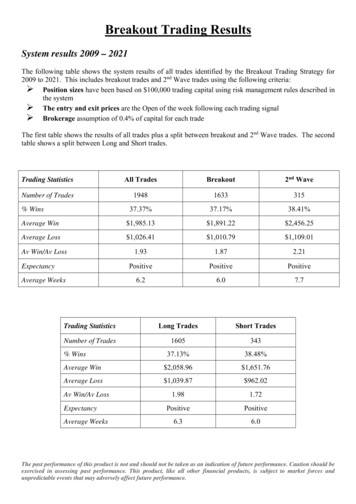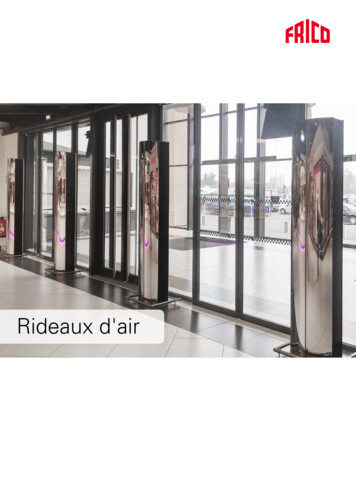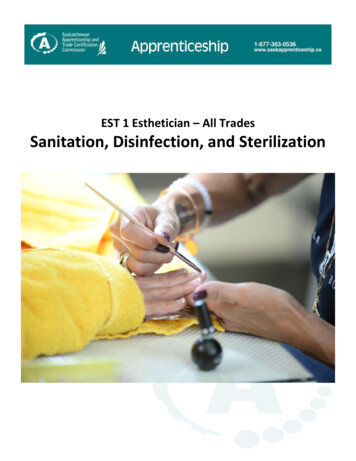
Transcription
EST 1 Esthetician – All TradesSanitation, Disinfection, and Sterilization1
2Revised: August, 2020
This guide is for informational and educational purposes only to provide estheticians with an overview on howto develop safe, appropriate sanitation, disinfection, and sterilization practices. While every effort has beenmade to ensure the accuracy of the information contained herein, this guide should not be relied upon as thesole source of information on the subject matter nor does SATCC accept any responsibility to update this guideas better or other information becomes available. The provisions of The Public Health Act, 1994 and TheHealth Hazard Regulations are the official guiding legislation and shall be considered authoritative to theextent they differ from this guide. In the event of uncertainty, you should direct any questions or concerns toyour local Public Health Officer or relevant authority having jurisdiction (AHJ).3Revised: August, 2020
Prepared by the Saskatchewan Apprenticeship and Trade Certification Commission (SATCC) for educationalpurposes. No part of this booklet may be reproduced, copied, or transmitted in any form or by any means,without written permission by the SATCC.This book was developed by the SATCC and the Esthetician Trade Board membership.Special thanks to Damaris Terleski, Nove Salon & Esthetics Wholesale Ltd, and Veronica Lynne-Swirsky of SpaAcademy.4Revised: August, 2020
Covid-19 UpdateDue to the current health crisis across Canada, while performing client services. various safeguards have beendeveloped and put in place for the safety of Estheticians and their clients.The Government of Saskatchewan announced the Re-Open Saskatchewan Plan April 23, 2020.In alignment with the Re-Open Saskatchewan Plan, the SATCC has developed its own plans to re-start SATCCservices that were paused due to COVID-19.Safety is the top priority for our employees and clients, and citizen service was a key consideration indetermining when to re-start services.We are re-starting services gradually, following the direction of public health officials.Our plans are flexible and may need to change, depending on the circumstances of the COVID-19 pandemic.For updated information please refer to: sments/Regarding Esthetician Journeyperson practical examinations, safeguards have also been put in place to ensurethe safety of the Esthetician candidate, their model and SATCC staff. Updated practical examinationinformation has been added to the current Practical Examination Information Sheet for both Esthtechian-NailTechnician and Esthetician-Skin Care Technician practical examinations. Please ensure you have the updatedversion of these documents when preparing for the practical examination.The current Examination Information Sheet documents are available at: d-trades/ Under the Esthetician- Nail Technician or Esthetician-Skin Care Technician trade tabs.5Revised: August, 2020
Table of ContentsObjective One . 11Scope of Practice . 11Personal Protective Equipment (PPE) and Supplies . 11Hand Washing . 12What Does “Clean” Mean? . 13An Overview of Sanitizing, Disinfecting, and Sterilizing . 13What is Sanitizing? . 14What is Disinfecting? . 14Critical Items . 14Semi-Critical, and non-Critical Items . 15What is Sterilizing? . 16Storage of Clean Items . 16Objective One Self-Test . 17Objective One Self-Test Answers. 19Objective Two . 20Sanitizing Surfaces . 20Disinfecting Surfaces . 20Disinfecting Surfaces With Disinfectant Wipes . 20Portable Foot Basins . 216Revised: August, 2020
Whirlpool Foot Spas, Air-Jet Basins, “Pipe-less” Foot Spas and OtherCirculating Spas* . 22Objective Two Self-Test . 23Objective Two Self-Test Answers . 24Objective Three . 25Objective Three Self-Test . 26Objective Three Self-Test Answers . 27Objective four . 28What can be Disinfected? . 28Disinfecting Instruments . 28Bits for Electric Files . 28Linens . 29Personal Care Packs and Client-Provided Tools . 29Rocks and Marbles . 30Objective Four Self-Test . 31Objective Four Self-Test Answers . 33Objective Five . 34Choosing a Chemosterilant / High Level Disinfectant . 34Re-use Time . 34Objective Five Self-Test . 37Objective Five Self-Test Answers . 38Objective Six . 39Objective Six Self-Test . 407Revised: August, 2020
Objective Seven . 41Manufacturer’s Specifications . 41Purchasing Supplies . 42Objective Seven Self-Test . 43Objective Seven Self-Test Answers . 44Objective Eight . 45Contamination Types . 45Accidental Exposure to Blood and Body Fluid . 45Remediating a Contamination . 46Objective Eight Self-Test . 47Objective Eight Self-Test Answers . 48Objective Nine . 49General Practices . 49Sanitation Between Clients . 49Linens . 50Daily Sanitation . 50Records and Logs . 51Autoclave Records . 52Objective Nine Self-Test . 53Objective Nine Self-Test Answers . 55Objective Ten. 56Contact Surfaces . 56Laundry . 568Revised: August, 2020
Steam Sterilization . 56Manicures and Pedicures . 57Warts. 57Blades . 57Cuticles . 58Paraffin Wax. 58Porous and Non-Porous . 58Brushes and Applicators. 58Module Summary Self-Test . 60Module Summary Self-Test Answers . 649Revised: August, 2020
Sanitation, Disinfection, andSterilizationRationaleWhy is it important to learn this skill?When working on people, it is important to practice the highest standard of sanitation to prevent the spreadof communicable diseases and infections; some can be fatal. The knowledge and practice of sanitation /disinfection / sterilization (SDS) will reduce the risks.OutcomeWhen you have completed this module, you will be able to:Describe and demonstrate proper sanitizing, disinfecting, and sterilizing in the esthetician industry for theprevention of diseases and infections.Objectives1. Describe the proper terminology used in the Esthetics industry.2. Describe sanitizing and disinfecting surfaces.3. Demonstrate sanitizing and disinfecting surfaces.4. Describe sanitizing and disinfecting instruments.5. Describe how to sterilize instruments.6. Demonstrate sanitizing, disinfecting, and sterilizing instruments.7. Describe manufacturer’s specifications.8. Describe disposal and sterilization procedures for contamination.9. Describe best practices for salon sanitation.10. Unanswered questions and contradictions.IntroductionUnderstanding followed by responsible, thorough actions is paramount in the esthetics industry. Nowhere isthis more important than in sanitation, disinfection, and sterilization. This module will provide apprenticeswith the information and confidence needed to operate safe salons. The information here is based on apermanent salon. Temporary salons may have special guidelines which are not included.For further reading:10Revised: August, 2020
Best Practices for Environmental Cleaning for Prevention and Control of InfectionsIn All Health Care Settings - 2nd edition. Provincial Infectious Diseases Advisory Committee (PIDAC). 2012.Government of Ontario. Saskatchewan Personal Service Facility Best Management Practices. 2014. Government of Saskatchewan.Objective OneWhen you have completed this objective, you will be able to:Describe the proper terminology used in the Esthetics industry.Scope of PracticeA scope of practice is the procedures, actions, and processes that a person is permitted to undertake inperforming their job. A scope of practice is defined within the law and limited by education, experience,training, and competency. Always consult with the authority having jurisdiction (AHJ) to be sure of a scope ofpractice. Examples of AHJ’s include local and provincial health authorities, and Infection and ControlDepartments. Within their scope of practice, an esthetician cannot cut into live tissue, cannot diagnosediseases and disorders. Callus can be reduced, but not removed. Estheticians learn to recognize diseases anddisorders, but cannot treat medical ailments. Estheticians can provide aid to some conditions such as excesscallus reduction, and ingrown toenail prevention.For example, a client presents with onychomycosis under a nail. Estheticians may recognize thisdisease, but they cannot inform the client of their opinion, nor can they suggest treatmentmethods; instead, they should refer the client to a physician. An esthetician could say to theclient: “this looks abnormal to me, please have a physician check this.”Personal Protective Equipment (PPE) and SuppliesExposure to the chemicals in this booklet can cause negative health effects. The use of PPE (gloves, eyeprotection, breathing protection, and proper clothing) can reduce exposure. Refer to EST 2 for a complete listof PPE for this trade. Only commercial grade supplies should be purchased. Salon distributors arerecommended because they have access to a wide variety of commercial grade products. Home-use productsare not acceptable because they have not been tested in a commercial setting.11Revised: August, 2020
Hand WashingIt is crucial that proper hand washingtechniques are performed before and aftereach service. Hand washing will removedebris and pathogens from flat areas of skin,skin folds, and under nails. Hand sanitizeralone will not remove debris; it will only slowreproduction of bacteria temporarily.Thoroughly wash hands with a soft-bristled,disinfected brush, liquid soap, and warmrunning water. Dry hands completely withdisposable towels and then apply an alcoholbased hand sanitizer. Water-based sanitizersare not effective enough for a salon. Washinghands after the service is performed willreduce the risk of transferring pathogens; inaddition, hand washing after the service canreduce the possibility of developing contactdermatitis. Contact dermatitis is a conditionthat can result from over exposure toenhancement products being left on skin forextended periods of time. Provide clean,disinfected brushes for each client, becausebacteria can transfer to or from a brush. Storeused brushes in a sterilisable bowl. Follow theprocedures in this booklet to properly cleanthe brushes and bowl.12Revised: August, 2020
What Does “Clean” Mean?An apprentice needs to understand the term “clean” for two main reasons. First, a task can only be completedproperly if an apprentice knows what the finished job is supposed to look like. If an apprentice is told to“clean” something, they must know what “clean” means in order to perform the task properly. Secondly,“clean” is often used as a baseline, or measurement, or point of reference. Some surfaces and tools only needto be “clean.” For other surfaces and tools, “clean” is not good enough and they must be sterilized. Here is asimple and functional definition for clean: tools and surfaces are, at a minimum, disinfected.An Overview of Sanitizing, Disinfecting, and SterilizingIn the esthetics industry, surfaces and tools must be clean in order to prevent the spread of diseases andinfections. Generally, prevention is a three stage process (precise actions in a certain order). The processbegins with the removal of gross debris such as dirt and skin cells. The next two stages further reduce theneliminate pathogens. The goal is to have an environment that is theoretically devoid of pathogens (keeping inmind that air itself contains pathogens) and this is never truly possible. Strict adherence to the correct processis necessary to health and safety. It is important to continually inspect instruments and surfaces for signs ofdamage, defect, and debris such as blood and body fluids. remove gross debrisSanitize wash with soap and warm running waterDisinfect kill pathogens kill pathogensSterilize kill non-pathogensPorous and Non-Porous MaterialsPorous materials and non-porous materials are treated differently. A porous material has minute spaces orholes through which liquid or air may pass. Non-porous material does not have spaces of holes through whichliquid or air may pass. A porous material cannot be disinfected, while a non-porous material can bedisinfected. For example, a glass tool can be disinfected, while a pumice stone cannot.13Revised: August, 2020
What is Sanitizing?Many text books describe Sanitizing as a process of removing gross debris. This reduces the number ofdisease-causing germs on clean surfaces to a safe level. Sanitizing can be stated in simpler terms: washingsomething with soap and water. For example, instruments can be sanitized by scrubbing the tool underrunning warm water with soap and a brush. Surfaces can be sanitized by wiping the area with soapy waterand a cloth.It needs to be understood that ‘safe level’ in the definition of sanitizing does not mean that tools are not readyfor re-use. Tools must undergo further treatment before being safe for re-use. Rinsing is always done withclean running water.What is Disinfecting?Disinfecting is the process that eliminates most, but not necessarily all micro-organisms on non-poroussurfaces. This process is not effective against bacterial spores. A bacterial spore is a spore or spore-likestructure produced by bacteria. Spore formation in bacteria is not the principal method of reproduction butsimply a method of surviving unfavourable conditions. After sanitizing, disinfecting is the next stage.Disinfecting requires the use of a chemical other than the soap that was adequate in the previous stage. In asalon, a countertop will be washed with warm soapy water and then allowed to dry. Next, the area is sprayedwith a surface disinfectant and allowed to remain wet for a period of time. Contact time is a time period thatallows a product to ‘do its job.’ If a disinfecting spray has as contact time of ten minutes, the surface mustremain wet with the product for at least ten minutes in order for the spray to perform properly. All productshave their own unique characteristics, and many have different contact times. It is important to read thelabels of each product.Critical ItemsCritical items include instruments intended to or accidentally penetrate the skin or mucus membrane, orcontact a puncture site; for example, cuticle nippers or tweezers that have contacted blood or live tissue.Critical items must be sterilized because they have a high risk of spreading infectious diseases.14Revised: August, 2020
Semi-Critical, and non-Critical ItemsItems need to be disinfected to different levels depending on how critical the item onLevel of disinfectionAny instrument contacting non-intact skin or amucus membrane*, but does not penetrate it(ingrown nail file or cuticle nippers)High level disinfection(HLD)Any instrument contacting intact skin only (cuticlepusher)Intermediate leveldisinfection (ILD)Any instrument or equipment that does not directlycontact the client or contacts only intact skin(UV/LED lamp)Low level disinfection(LLD)*A mucous membrane is made up of layers of cells and connective tissues located on body cavities, tracts,canals, and structures that lead to the outside of the body. Of importance to estheticians are the mucusmembranes located in/around the mouth, nose, and eyelids.Level of DisinfectionDescriptionHigh level disinfection(HLD)A process capable of destroying or irreversibly inactivating bacteriathat can sit dormant such as tuberculosis; fungi; enveloped viruses;non-enveloped viruses; and some bacterial endosporesIntermediate leveldisinfection (ILD)A process capable of destroying or irreversibly inactivating bacteriathat can sit dormant such as most fungi; enveloped viruses; and mostnon-enveloped viruses15Revised: August, 2020
Low level disinfection(LLD)A process capable of destroying or irreversibly inactivating, at aminimum, vegetative bacteria, some fungi, enveloped (lipid) virusesand some non-enveloped (non-lipid) virusesAn apprentice may hear the term Hospital-Grade Disinfectant: A low-level disinfectant that has a drugidentification number (DIN) from Health Canada indicating its approval for use in Canadian hospitals.What is Sterilizing?Sterilizing is the process that eliminates all pathogens from an instrument. It is important to note that afteran instrument is submerged in chemosterilant for the contact time, it is sterile. A chemosterilant is a chemicalused for sterilizing. Once the instrument contacts air, it is not considered sterile, but rather disinfected. Usingan autoclave is a reliable way to ensure that instruments maintain sterility because they are sterilized in anairtight package. Some facilities place tools in an autoclave without using a sterilization pouch. After theautoclave cycle is complete, the tools are placed in a container. In this case, these tools are not consideredsterile, but rather disinfected. A surface cannot be sterilized, because it cannot be submerged inchemosterilant and it is in constant contact with air.Storage of Clean ItemsAfter an item has been cleaned to its appropriate level and thoroughly dried (by air or a paper towel) it mustbe stored. The best option for instruments is storage in sterilizing pouches. These pouches are one-time useonly, which prevents the mistake of reusing a storage bag such as a Ziploc bag. Other options include air tightcontainers. Large items such as moveable foot basins can be stored in a cupboard with the doors closed todecrease air exposure. In the photo above, instruments are stored in self-sealing sterilization pouches.16Revised: August, 2020
Objective One Self-Test1) Match the following terms with the correct definitions:Sterilizationthe procedures, actions, and processes that a person is permitted to undertakein performing their job.Hospital gradedisinfectiontools and surfaces are, at a minimum, disinfected.Scope ofpracticea process for reducing the number of diseasecausing germs on clean surfaces to a safe level.Cleanthe process that eliminates most, but not necessarily all micro-organisms onnon-porous surfaces. This process is not effective against bacterial spores.Sanitizinga time period that allows a product to ‘do its job.’Contact timemeans that a disinfection product kills the tuberculosis virus in less than 10minutes.Disinfectingthe process that eliminates all pathogens from an instrument.2) List three things that are outside an esthetician’s scope of practice.3) Why is it important to know what ‘clean’ means?4) What is a non-critical item?17Revised: August, 2020
5) What is intermediate level disinfection?6) What is the best option for storing items after they have been cleaned to the appropriate level?18Revised: August, 2020
Objective One Self-Test Answers1) Match the following terms with the correct definitions:Sterilizationthe procedures, actions, and processes that a person is permitted to undertakein performing their jobHospital gradedisinfectiontools and surfaces are, at a minimum, disinfected.Scope ofpracticea process for reducing the number of diseasecausing germs on clean surfaces to a safe level.Cleanthe process that eliminates most, but not necessarily all micro-organisms onnon-porous surfaces. This process is not effective against bacterial spores.Sanitizinga time period that allows a product to ‘do its job.’Contact timemeans that a disinfection product kills the tuberculosis virus in less than 10minutes.Disinfectingthe process that eliminates all pathogens from an instrument.2) An esthetician cannot cut into live tissue, diagnose diseases, diagnose disorders,Remove callus, and treat medical ailments.3) An esthetician needs to know what ‘clean’ means in order to properly complete atask, and ‘clean’ is often used as a baseline, or measurement, or point of reference.4) Any instrument contacting intact skin only, or any instrument or equipment thatdoes not directly contact the client or contacts only intact skin.5) A process capable of destroying or irreversibly inactivating bacteria that can sitdormant such as tuberculosis; most fungi; enveloped viruses; and non-envelopedviruses.6) The best option for instruments is storage in sterilizing pouches.19Revised: August, 2020
Objective TwoWhen you have completed this objective, you will be able to:Describe sanitizing and disinfecting surfaces.Sanitizing SurfacesCommon surfaces that need sanitizing include countertops, workstations, and equipment such as beds andlamps. One method of sanitizing surfaces is to thoroughly wash them with a clean cloth and soapy water. Letthe surface dry. A second method of sanitizing a surface is to wipe the surface with a disinfectant wipe (suchas PREempt Wipes / CaviWipes ).Disinfecting SurfacesAfter a surface has been sanitized, it is ready for disinfection. Most often, a spray such as CaviCide is used.This spray disinfects hard, non-porous surfaces where environmental controls of cross contamination betweentreated surfaces is important. The contact time for CaviCide1 is one minute. Once the surface is dry fromsanitizing, spray it with an approved product and ensure that the surface remains wet for the minimumcontact time. Some manufacturers require that surfaces be rinsed with clean water after the contact time hasexpired. Surfaces can be air dried or dried with a paper towel. Never use a cloth. It is important to read thelabels of each product. Apply spray products carefully to minimize introducing the chemical into the air whichcan be inhaled.Disinfecting Surfaces With Disinfectant WipesSurfaces can be disinfected with disinfectant wipes. The area is cleaned thoroughly with the first wipe, thenthe wipe is discarded. A second wipe is used to cover the area with a disinfecting solution. Wet the area withthe second wipe, making sure that the area stays wet for the minimum contact time. In order to ensure thatthe area remains wet for the minimum time, the wipe can be laid over the area. For example, a wipe can belaid inside a tunnel lamp after it has been initially cleaned. If an area is in danger of drying after the firstcleaning, the area can be sprayed with the same brand of surface disinfectant to keep it wet.20Revised: August, 2020
Portable Foot BasinsPortable foot basins must be metal or glass because thesematerials can be disinfected. Glass is not recommendedbecause it is breakable. Over time, scratches can weakenthe glass, making it prone to failure. Plastic basins cannotbe disinfected because they are porous. In order todisinfect a portable foot basin, follow these steps. Stepone: scrub the entire basin—inside and out—with soapand warm running water; rinse; and, dry with paper towel.Step two: spray the inside of the basin with a surfacedisinfectant, then cover the inside of the basin with papertowel. Make sure to spray the paper towel untilSteel foot basinsaturated. This ensures that the surface remains wet forthe minimum contact time. Once the contact time is met,remove the paper towel and rinse if required by the manufacturer’s specifications. Dry and store in acupboard or other protected location that will reduce its chances of contamination. Even when using a liner,the basin must still be disinfected.Disposable liners for basin on the right21Revised: August, 2020
wash withsoap andwarm runningwaterdryspray withsurfacedisinfectantfor minimumcontact timerinse, dry,storeWhirlpool Foot Spas, Air-Jet Basins, “Pipe-less” Foot Spasand Other Circulating Spas*After Each Client1. Drain the foot spa and remove any visible contaminants.2. Remove screen.3. Wash and scrub the basin with soap and warm water.4. Fill the foot spa with soap and warm water to above the fill line and turn on therecirculation system as per manufacturer’s directions.5. Drain and rinse with clean water.6. Fill the spa with an intermediate-level disinfectant.7. Turn on the recirculation system and allow the disinfectant to run through the unit.8. Drain the foot spa and rinse with clean water.9. Replace screen.At the end of the day1. Drain the foot spa.2. Remove the filter screen, jets, all removable parts and any visible contaminants.3. Clean the basin, screen, jets and other removable parts with soap, water, and abrush.4. Reassemble unit.5. Fill the foot spa with water and low sudsing detergent, turn on the re-circulationsystem and allow to run as per manufacturer’s directions.6. Drain and rinse the unit again, refill with water and a high-level disinfectant.7. Turn on the re-circulation system and allow to operate as per manufacturer’sdirections.22Revised: August, 2020
8. Drain the unit, rinse with clean water.*Ensure
Regarding Esthetician Journeyperson practical examinations, safeguards have also been put in place to ensure the safety of the Esthetician candidate, their model and SATCC staff. Updated practical examination information has been added to the current Practical Examination Information Sheet for both Esthtechian-Nail
